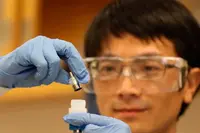Electronics News
Archive : 8 November 2015 год
 Following the merger announcement earlier this year by the Alliance for Wireless Power (A4WP) and Power Matters Alliance (PMA), the two organisations have rebranded under the AirFuel Alliance banner. The combined body has 195 members.
Following the merger announcement earlier this year by the Alliance for Wireless Power (A4WP) and Power Matters Alliance (PMA), the two organisations have rebranded under the AirFuel Alliance banner. The combined body has 195 members.
“AirFuel technology is the next step in fast tracking the commercialisation of wirelessly charged products,” said Alliance president Ron Resnick. “The introduction of AirFuel is a clear step in the right direction for true wireless charging.”
After a suitable grace period, the brands associated with A4WP and PMA will be retired and, from that point, certified products will carry the AirFuel name and logo.
AirFuel Alliance continues to support the use of multimode systems that operate with both versions of the standard, but notes its uncoupled working group is developing technologies that go beyond the use of magnetics.
Author
Graham Pitcher
Source: www.newelectronics.co.uk
![]() A research team led by Matthew Grayson, associate professor of electrical engineering and computer science in Northwestern's McCormick School of Engineering, has created a mathematical method claimed to make semiconductor characterisation more efficient, more precise, and simpler. By flipping the magnetic field and repeating one measurement, the method is said to quantify whether or not electrical conductivity is uniform across the entire material.
A research team led by Matthew Grayson, associate professor of electrical engineering and computer science in Northwestern's McCormick School of Engineering, has created a mathematical method claimed to make semiconductor characterisation more efficient, more precise, and simpler. By flipping the magnetic field and repeating one measurement, the method is said to quantify whether or not electrical conductivity is uniform across the entire material.
"Up until now, everyone would take separate pieces of the material, measure each piece, and compare differences to quantify non-uniformity," Grayson said. "That means you need more time to make several different measurements and extra material dedicated for diagnostics. We have figured out how to measure a single piece of material in a magnetic field while flipping the polarity to deduce the average variation in the density of electrons across the sample."
One reason semiconductors have so many applications is because researchers and manufacturers can control their properties. By adding impurities to the material, researchers can modulate the semiconductor's electrical properties. The trick is making sure that the material is uniformly modulated so that every part of the material performs equally well. Grayson's technique is said to allow researchers and manufacturers to directly quantify such non-uniformities.
"When people see non-uniform behaviour, sometimes they just throw out the material to find a better piece," Grayson said. "With our information, you can find a piece of the material that's more uniform and can still be used. Or you can use the information to figure out how to balance out the next sample."
Grayson says his method can be applied to samples as large as a 12-inch wafer or as small as an exfoliated 10µm flake, allowing researchers to profile the subtleties in a range of semiconductor samples. The method is claimed to be especially useful for 2D materials, such as graphene, which are too small for researchers to make several measurements across the surface.
Grayson has filed a patent on the method, and hopes the technique will find use in academic laboratories and industry.
Pic: Matthew Grayson, associate professor of electrical engineering and computer science in Northwestern's McCormick School of Engineering
Author
Tom Austin-Morgan
Source: www.newelectronics.co.uk
 AMD says it has taped out multiple products using Globalfoundries’ 14nm low power plus (14LPP) process technology and is currently conducting validation work on 14LPP production samples. The 14LPP platform uses fully depleted FinFET transistors to deliver more processing power in a smaller footprint.
AMD says it has taped out multiple products using Globalfoundries’ 14nm low power plus (14LPP) process technology and is currently conducting validation work on 14LPP production samples. The 14LPP platform uses fully depleted FinFET transistors to deliver more processing power in a smaller footprint.
“FinFET technology is expected to play a critical foundational role across multiple AMD product lines, starting in 2016,” said Mark Papermaster, AMD’s chief technology officer. “We look forward to Globalfoundries' continued progress towards full production readiness and expect to leverage the advanced 14LPP process technology across a broad set of CPU, APU and GPU products.”
According to Globalfoundries, the 14LPP FinFET process is ramping at Fab 8, pictured, in New York state. “Our 14nm FinFET technology [offers] an ideal solution for demanding high volume, high performance and power efficient designs with the best die size,” claimed Mike Cadigan, senior vice president of product management at Globalfoundries.
Author
Graham Pitcher
Source: www.newelectronics.co.uk
 Scientists at the Lawrence Livermore National Laboratory (LLNL) in the US have found that lithium ion batteries can operate for longer and more quickly when their electrodes are treated with hydrogen.
Scientists at the Lawrence Livermore National Laboratory (LLNL) in the US have found that lithium ion batteries can operate for longer and more quickly when their electrodes are treated with hydrogen.
“The performance improvement we’ve seen in the electrodes is a breakthrough that has real world applications,” said Jianchao Ye, pictured, staff scientist in LLNL’s Materials Science Division.
According to the team, several key characteristics of lithium ion batteries, such as capacity, voltage and energy density, are determined by the binding between lithium ions and the electrode material. In their experiments, the researchers discovered that hydrogen treated graphene nanofoam electrodes show higher capacity and faster transport.
The team says the chemical synthesis methods used to create such batteries often leave behind significant amounts of atomic hydrogen. It found that by treating defect rich graphene with hydrogen at low temperatures, rate capacity could be improved. In the process, hydrogen interacts with defects in the graphene structure, opening small gaps that allow lithium ions to penetrate more easily.
Author
Graham Pitcher
Source: www.newelectronics.co.uk

